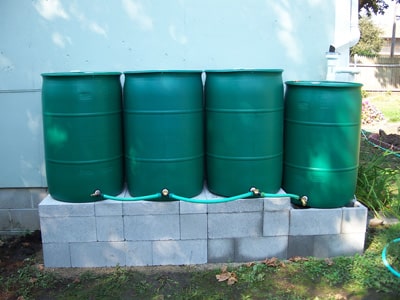Stormwater is water that used to soak into the ground and become ground water prior to development but runs off of impervious surfaces, collecting pollutants until it ultimately enters our surface waters. These pollutants include trash, chemicals, sediment, and oils among many others. Population growth and development rates are increasing the amount of pollutions and the volume and rate of runoff from impervious surfaces. Stormwater runoff pollution causes changes in hydrology and water quality that then result in habitat modifications, increased flooding, decreased aquatic biological diversity, and increased sedimentation and erosion. Best management practices (BMPs) filter out pollutants and/or prevent pollution by controlling it at its source.
Rain barrels and cisterns capture and store stormwater from downspouts to be used instead of potable water resources. Most commonly, the water harvested from rain
barrels is used to water lawns, gardens, or indoor plants for free instead of tacking these water expenses onto your water utility bill. While this water is typically healthier than potable water for plants, it can contain pollutants like bacteria from birds and other animals as well as chemicals from roofing materials, so water from rain barrels cannot be consumed. Some choose to use this water on edible plants, but that decision is up to the discretion of the user.
Benefits of Rain Barrels and Cister ns: Outdoor irrigation accounts for one third of all residential water use, coming in at about 7 billion gallons every day. By decreasing the amount of potable water used for this purpose, rain barrels can substantially reduce the amount of potable water used residentially and increase the available water supply. This also cuts down on the energy used to produce, treat, and transport potable water supplies and the associated emissions like carbon dioxide. Using rain water on plants has also been shown to improve plant health, as this water contains nitrogen and phosphorus instead of the salt in potable water.
ns: Outdoor irrigation accounts for one third of all residential water use, coming in at about 7 billion gallons every day. By decreasing the amount of potable water used for this purpose, rain barrels can substantially reduce the amount of potable water used residentially and increase the available water supply. This also cuts down on the energy used to produce, treat, and transport potable water supplies and the associated emissions like carbon dioxide. Using rain water on plants has also been shown to improve plant health, as this water contains nitrogen and phosphorus instead of the salt in potable water.
Costs: Rain barrels can be obtained from annual community sales, private retailers, or rain barrel workshops like those held by Tinker’s Creek Watershed Partners for varying amounts of money. The operation and maintenance costs of rain barrels are estimated to be about $7 per downspout disconnected per year. Using cisterns for things like toilet flushing and restroom needs has higher up-front capital costs and maintenance requirements, but utilizing rain barrels and cisterns for non-potable water uses can save you significant amounts of money on your water bills.
